How to Grow Flowers Quickly: Simple Tips for a Blooming Garden
If you’re eager to see a splash of color in your garden without the long wait, fast-growing flowers are the way to go. These flowers not only bring beauty quickly, but they also invite birds and bees, making your garden lively. The key to growing flowers quickly is choosing varieties known for their fast growth and ensuring they receive proper sunlight, water, and nutrients.
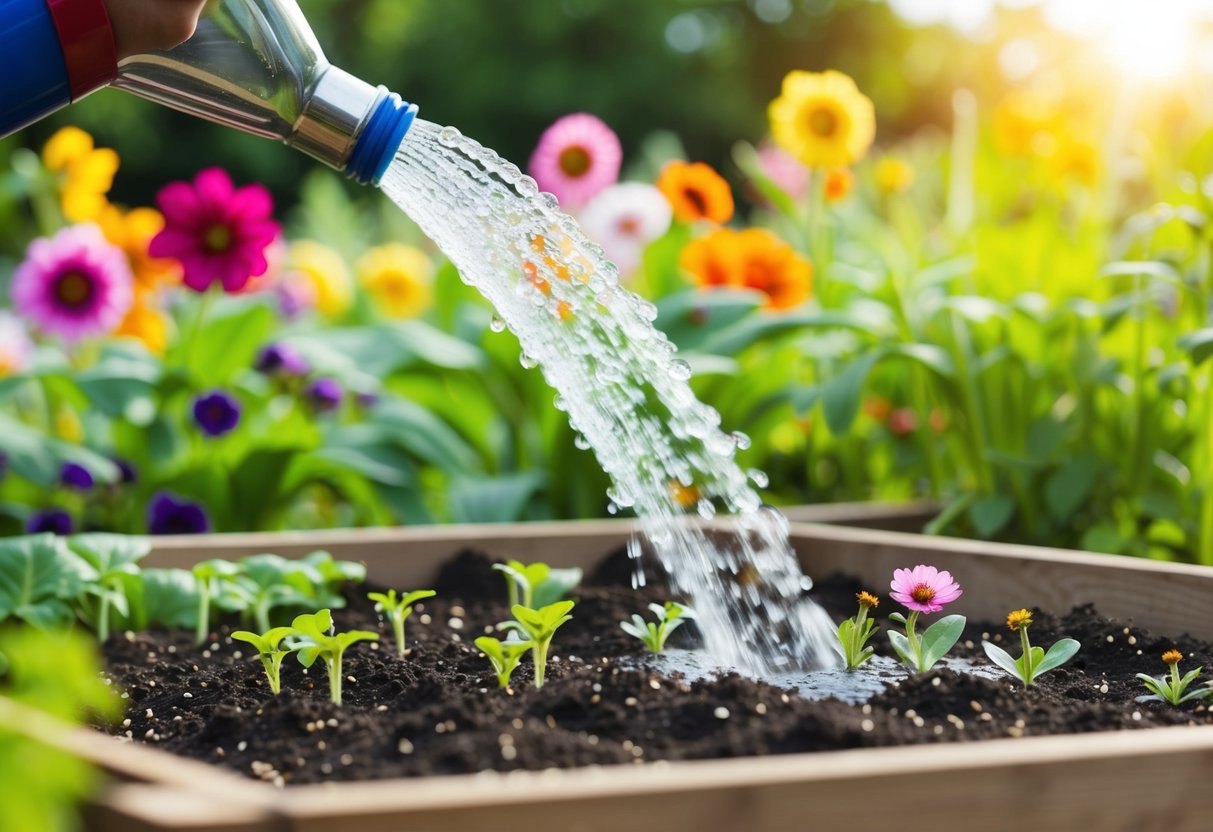
Planting options like zinnias, marigolds, and sunflowers can transform your outdoor space. Each of these flowers has its own charm and provides a unique touch to any garden. Plus, they’re perfect for gardeners who might have missed the planting window or are just starting out.
With the right seeds and care, you can enjoy vibrant blooms in just a few weeks. It’s important to keep your garden well-maintained to ensure continued growth and blooming. Whether you’re an experienced gardener or a beginner, fast-growing flowers promise quick results and a rewarding gardening experience.
Getting Started with Flower Gardening

When starting a flower garden, choosing the right flower seeds and ensuring optimum soil and sunlight conditions are crucial. This helps you grow a vibrant and healthy garden that blooms beautifully.
Choosing the Right Flower Seeds
Picking the right seeds is the first step toward a successful garden. Begin with seed packets that match your climate. Annual flowers like marigolds and zinnias bloom quickly and work well for beginners. They complete their life cycle in one growing season, giving you a burst of color.
On the other hand, perennial flowers like daisies and peonies come back each year. These are great for a garden that lasts long-term. Read the seed packets carefully to understand the specific needs of each flower type, such as water and spacing.
Consider starting your seeds indoors to give them a head start, especially in colder climates. This allows you to plant seedlings outdoors after the last frost.
Understanding Soil and Sunlight Requirements
The soil and sunlight in your garden are just as important as the seeds you choose. Most flowers thrive in well-drained soil that allows water to pass through, preventing root rot. To make sure your soil drains well, you can mix in organic matter like compost or peat moss.
Testing your soil’s pH can help too. Many flowers prefer slightly acidic to neutral soil.
Sunlight affects your flowers’ growth rate and vibrance. While some flowers need full sun for at least six hours a day, others do well in partial shade. Observe the sunlight in your garden before planting and arrange your garden accordingly to match each flower’s needs.
For best results, take note of both your location’s climate conditions and the specific requirements listed on the seed packets. This ensures that your flowers get off to a strong and healthy start.
Planting Techniques for Quick Growth
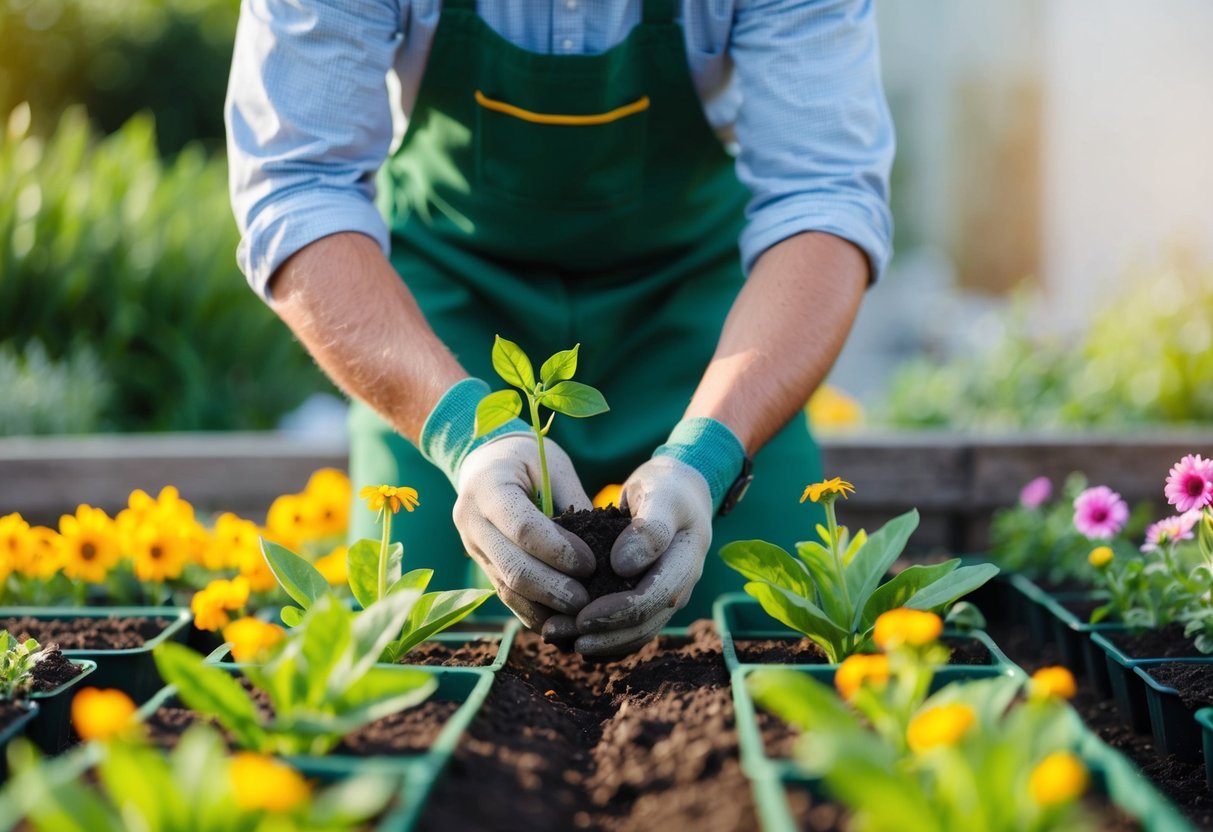
Growing flowers quickly involves understanding the essentials of seed germination and following the best planting practices. Getting these steps right helps your garden flourish with vibrant blooms in no time.
Seed Germination Basics
Before planting, focus on seed germination, the process where seeds develop into new plants. Start by soaking seeds in water for a few hours to kickstart the germination process. This softens the seed coat and allows moisture to penetrate.
Consider using a seed-starting mix. It is lightweight and provides the right balance of water retention and aeration.
Temperature plays a crucial role too. Most seeds need warmth to germinate, so aim for 65-75°F. Starting seeds indoors can help you control these conditions better.
To speed up germination time, ensure proper lighting. A sunny windowsill or artificial grow lights are excellent choices. Regularly check moisture levels, as seeds need consistent hydration but must not be waterlogged.
Best Practices for Planting Flowers
Once seeds germinate, it’s time to transplant them. Choose a spot in your garden with good sunlight and well-drained soil.
Soil preparation is key. Loosen the soil and mix in compost to enrich it with nutrients. You can also add a slow-release fertilizer to boost growth.
When planting, pay attention to spacing. Crowded plants compete for resources, so give each plant enough room to grow. This spacing prevents overcrowding and ensures healthy blooms.
Regular watering is crucial, especially during dry spells, but be careful not to overwater. To support rapid growth, mulch your flower beds. This helps retain moisture and suppresses weeds, giving flowers the best chance to thrive.
Optimal Growing Conditions
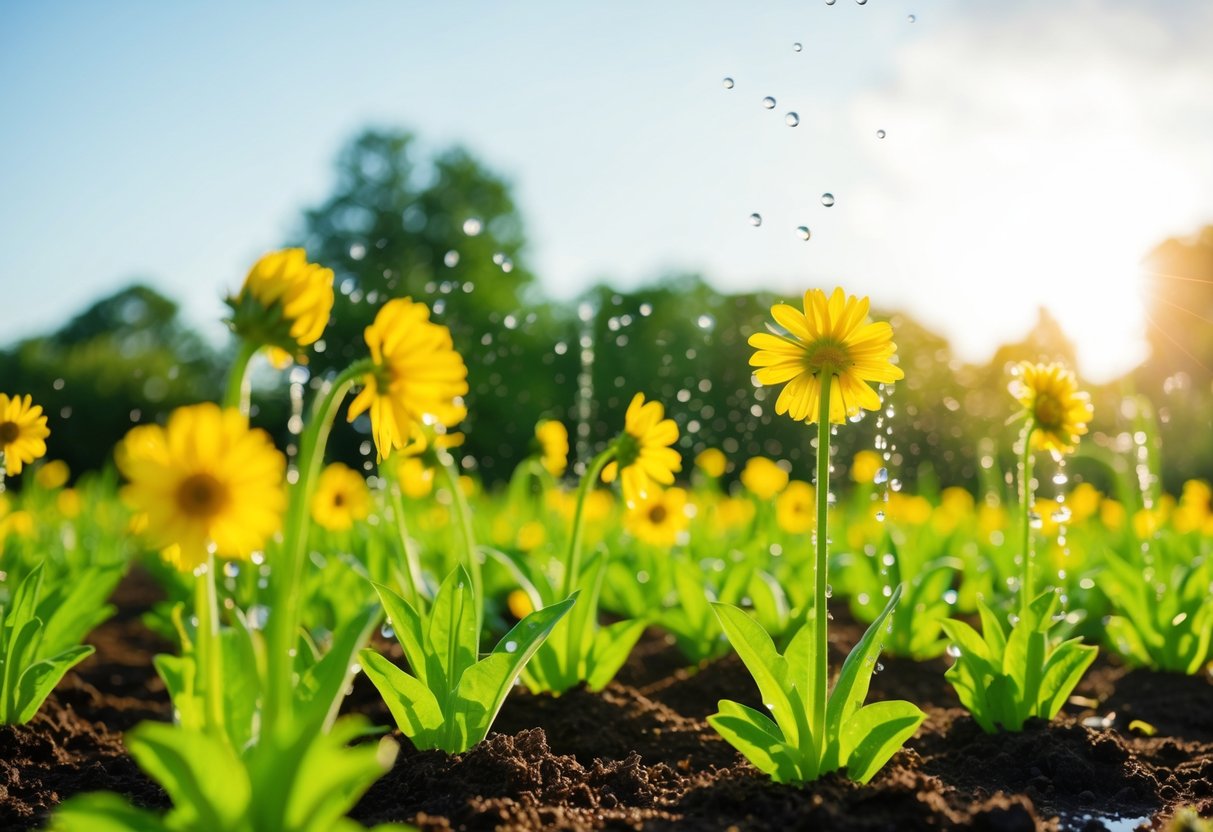
To grow flowers quickly and ensure they bloom beautifully, proper watering, fertilization, and managing sun exposure are key. These factors directly affect the health and growth rate of your flowers, with each playing a vital role in their development.
Watering and Fertilizing Your Flowers
Watering is crucial for your flowers to grow and bloom quickly. It’s best to water early in the morning, allowing moisture to reach deep into the soil. This helps the roots absorb nutrients efficiently. Be careful not to over-water, as this can lead to root rot, which slows bloom time.
Fertilizing your flowers keeps them healthy and supports rapid growth. Use a balanced fertilizer that contains equal parts nitrogen, phosphorus, and potassium. These nutrients are essential for strong roots, vibrant blooms, and overall plant health. You might also add a slow-release fertilizer to maintain consistent nutrient supply without frequent feeding.
Managing Sun Exposure and Temperature
Sun exposure is important for flower growth. Most flowers need about 6-8 hours of sunlight each day. If your flowers are in an area with too much shade, they might grow slowly or fail to bloom. If needed, relocate them to a sunnier spot for better growth.
Temperature also plays a big role in how fast flowers grow. Most flowers thrive in temperatures between 60-75°F (15-24°C), though this can vary by species. Protect flowers from extreme temperatures, which can stress plants and delay blooming. Using shade cloths on hot days or mulch to retain soil warmth in cooler weather can help maintain optimal conditions for your flowers.
Specific Flowers for Rapid Blooms
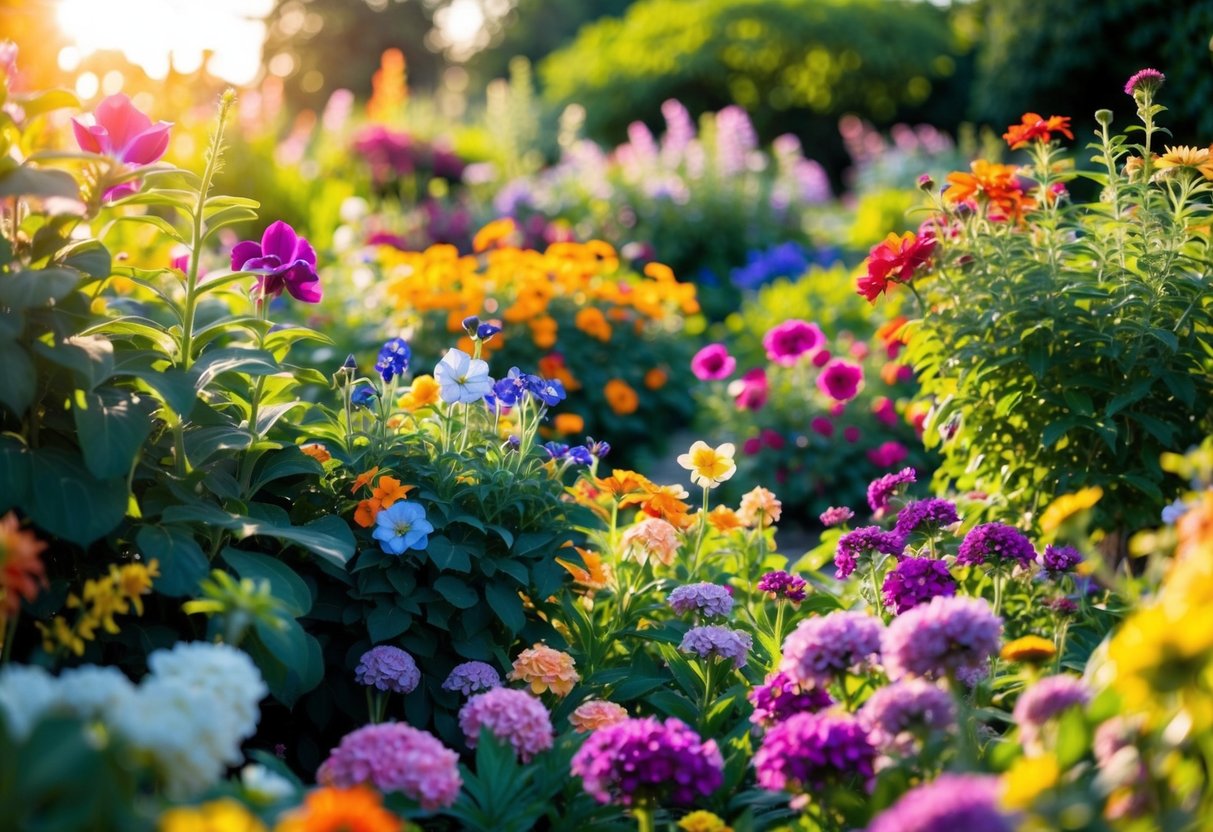
When you’re eager to see your garden flourish quickly, choosing the right flowers is key. Annuals like marigolds and zinnias sprout and bloom in a single season, offering immediate satisfaction. Perennials such as California poppies provide rapid growth year after year.
Annuals That Bloom Quickly
Annuals complete their life cycle in one growing season, making them perfect for quick color. Marigolds are a popular choice; they bring vibrant yellows and oranges to your garden in just weeks. These flowers are easy to care for and do well in full sun.
Consider zinnias for a bright and bold splash of color. They are hardy and grow quickly in sunny spots, attracting butterflies to your garden. Another great choice is the cosmos. These flowers are drought-tolerant and can grow in poor soil, making them ideal for those just starting out.
For a pop of color, petunias offer a wide range of hues and come with a delightful scent. Nasturtiums not only bloom quickly but are also edible, adding a spicy kick to your salads. These quick-blooming annuals will ensure your garden is filled with life rapidly.
Perennials Known for Speedy Growth
Perennials return year after year, often with minimal care. California poppies are a favorite, known for their quick blooms and vibrant orange petals. They self-seed and return each spring, making them a low-maintenance choice for any garden.
Sweet peas are another option, with their rapid growth and fragrant flowers. They climb happily on trellises and fences, adding a vertical element to your garden space. Morning glories also offer quick growth. These flowers unfurl every morning, adding waves of color with very little effort.
Sunflowers are perfect for those who want height and impact. Though they only bloom once a year, they grow fast and provide stunning visuals. These perennials ensure a lively and colorful garden season after season.
Maintaining Health and Vigor
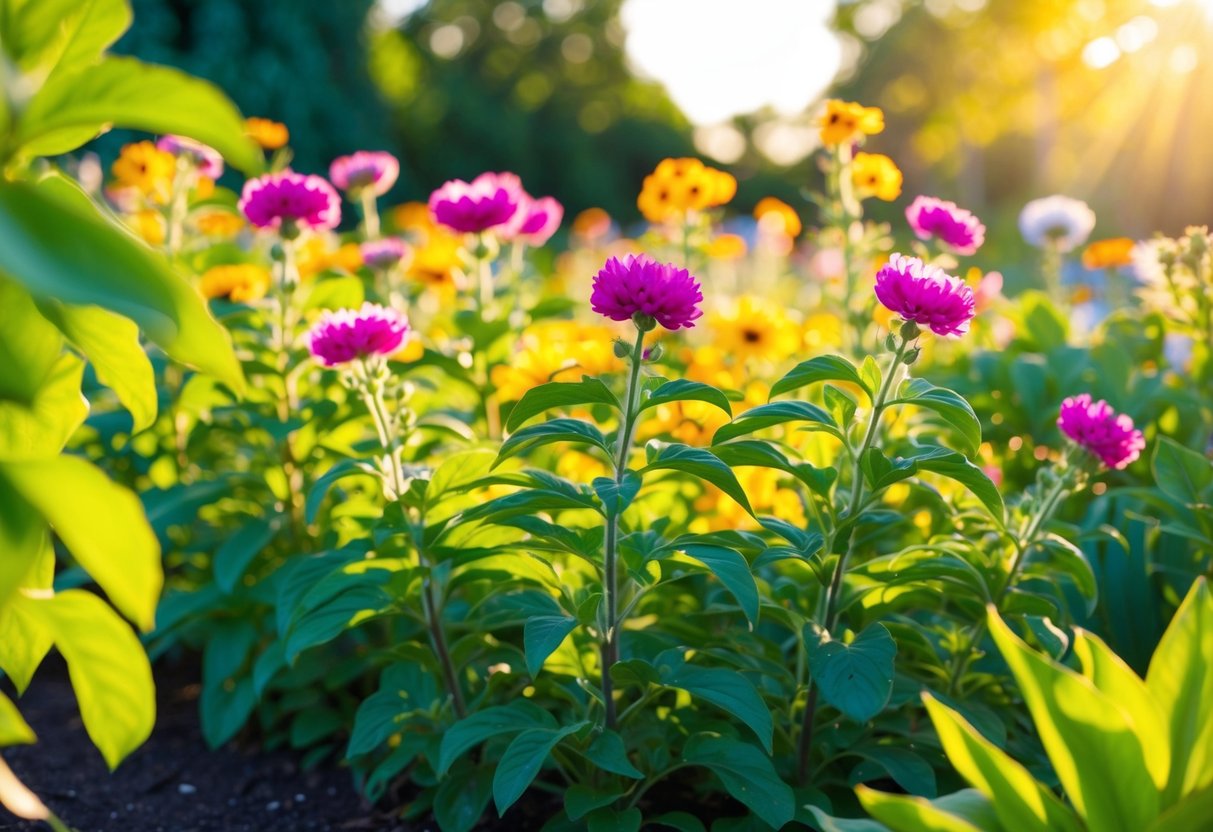
To ensure your flowers grow vibrant and strong, it’s important to protect them from pests and diseases while also encouraging new blooms. With the right care, your garden can be a haven for colorful and fragrant flowers.
Protecting Against Pests and Diseases
Keeping your flowers healthy means you need to watch out for pests and diseases. Consider planting flowers like marigolds to help deter harmful insects. A strategic trick is to attract beneficial insects like ladybugs and lacewings, which naturally keep pests in check by feeding on them. This creates a balance in your garden and helps lessen the need for chemical pesticides.
Inspect your plants regularly for signs of trouble. Look for holes in leaves or unusual discoloration, which may indicate pest or disease problems. Early detection can prevent more serious issues. Applying a mild soap spray can often help control small infestations on plants. Always ensure proper air circulation around your plants to prevent fungus growth.
Pruning and Deadheading for Continuous Blooms
Pruning and deadheading are key practices for maintaining a blooming garden. Pruning involves cutting back overgrown or damaged branches to encourage new growth and improve air circulation. This can also help shape your plants, making them more attractive.
Deadheading is removing spent or dead flowers from your plants. This encourages them to produce more blooms, keeping your garden full of color. Regularly removing dead flowers prevents the plant from setting seed, which often slows new flower production. This is particularly important for a cutting garden where fresh blooms are highly valued. Deadheading is simple and keeps your garden looking its best all season long.







